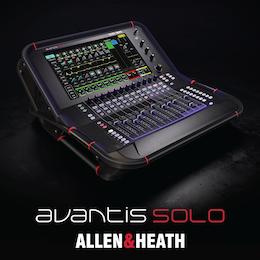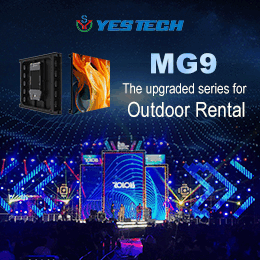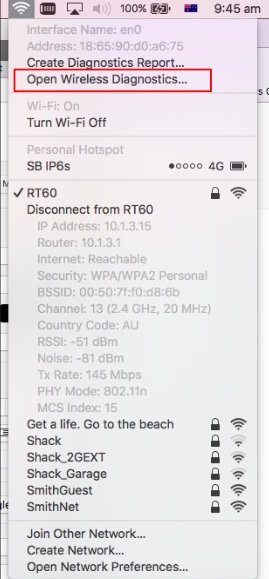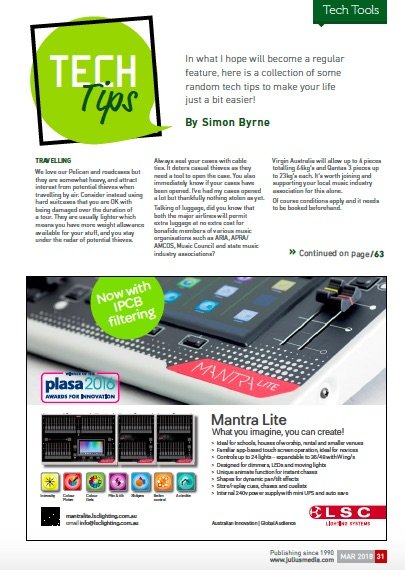Subscribe to CX E-News
TECH TOOLS
Tech Tips
In what I hope will become a regular feature, here is a collection of some random tech tips to make your life just a bit easier!
By Simon Byrne.
TRAVELLING
We love our Pelican and roadcases but they are somewhat heavy, and attract interest from potential thieves when travelling by air. Consider instead using hard suitcases that you are OK with being damaged over the duration of a tour. They are usually lighter which means you have more weight allowance available for your stuff, and you stay under the radar of potential thieves.
Always seal your cases with cable ties. It deters casual thieves as they need a tool to open the case. You also immediately know if your cases have been opened. I’ve had my cases opened a lot but thankfully nothing stolen as yet.
Talking of luggage, did you know that both the major airlines will permit extra luggage at no extra cost for bonafide members of various music organisations such as ARIA, APRA/AMCOS, Music Council and state music industry associations?
Virgin Australia will allow up to 4 pieces totalling 64kg’s and Qantas 3 pieces up to 23kg’s each. It’s worth joining and supporting your local music industry association for this alone. Of course conditions apply and it needs to be booked beforehand.
PRESS FEED CONFIDENCE MONITOR
We’ve all been there, just as the gig starts the media pile into the room and plug into the media splitter. You need to know it is working properly. You can set up your own confidence monitor from the media splitter back into a spare channel on the audio desk. That way you can PFL in your headphones the media splitter output anytime you like.
You obviously have to ensure that the channel you use for the confidence monitor does not output anywhere otherwise you could have some nasty feedback loops.
DESK RECORDINGS
For the corporate live sound operator, it is easy to forget to start the recording, it happens a lot. It leads to an uncomfortable conversation with the client because let’s face it, as far as they are concerned, is not that hard to press a record button.
The reason that it happens so much is because when the event first starts up, it is the first time the operator has got to listen to the PA with the audience in, so his/her attention is naturally taken up with settling the mix in the room. Recording forgotten…
With digital recorders, available record time is not an issue. Therefore it is a good practice is to start the recorder well before the event starts. I record all my jobs, even if the client does not ask because I’ve had a few ask after the gig and it is nice to be able to give it to them.
When recording the show, the levels will likely be different to what was expected so there is a risk that the input will clip. To get around this, I send a mono signal to both channels set up channel one to peak at say -12 dB, and channel two at about -30 dB. Channel two becomes the safety channel so if channel one is clipped, you’ve still got 18 dB of range on channel two.
If the recording is for purposes other than archival, it is worthwhile having another person look after it. It is unrealistic to expect a live sound operator to do a great job in the room, as well as deliver a broadcast quality recording.
HEADPHONES
You’ve got some, right? They don’t need to be the best sounding things because monitoring in a show is a poor environment to hear clearly, so you won’t be able to make critical judgements during the gig. You can though, quickly line check, fault find and check recordings, so they need to be capable of being loud without distortion and robust so as to stand up to the rigours of the road. Over the ear types are best as they do slightly better job of rejecting room noise.
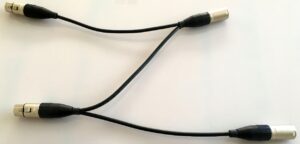 THE Z CABLE
THE Z CABLE
It’s as ugly as sin but it’s a get you out of the poo problem solver and it works great!
SHOW WIFI
With a lot of desks now offering remote control using apps, we rely a lot on wifi so it’s important to have it playing nicely. As with all RF, height is absolutely your friend when locating the router. You want a clear line of sight between your phone/tablet and the router’s wifi antennas. This is possibly the single most important thing that can be done to increase range and reliability.
2.4 Ghz or 5 Ghz? – The main differences between the two frequencies are the range (coverage) and bandwidth (speed) that the bands provide. The 2.4 GHz band provides coverage at a longer range but transmits data at slower speeds. The 5 GHz band provides less coverage but transmits data at faster speeds.
For control, you don’t need the speed advantages of 5 Ghz. However, if your router is capable of 5 Ghz and it reliably delivers the range you need, you should probably switch over to it. Only because every punter will also have a mobile phone, most of which will have wifi turned on and the 2.4 Ghz space becomes super congested.
Turn off SSID (service set identifier) in your router. The SSID is the broadcast name of your wifi network. There is no reason why you should advertise that your network is there. Smart hackers don’t need the SSID to find you, but why make is easy?
Still having problems? Apple Macs has some powerful hidden WiFi diagnostics built in, which help you understand what is going on in your environment. Hover over the WiFi icon in your OS X menu bar, hold down the Option key ⌥ and click the icon. This will show you a hidden dropdown menu where you’ll find Open Wireless Diagnostics — click on that.Once you’ve opened up the Wireless Diagnostics window, ignore it and head over to the top left of your menu bar and click on Window, then Scan.
In the Scan window, you’ll find a summary of the wireless networks in range, channels beings used, noise and signal strengths. On the left pane, you’ll find a breakdown of the wireless channels you’re currently using, and the recommended channels you should be using.

Have you got any tech tips worthy of publication? Send them to techtips@simonbyrne.com
This article first appeared in the print edition of CX Magazine March 2018, pp.31,63. CX Magazine is Australia and New Zealand’s only publication dedicated to entertainment technology news and issues. Read all editions for free or search our archive www.cxnetwork.com.au
Subscribe
Published monthly since 1991, our famous AV industry magazine is free for download or pay for print. Subscribers also receive CX News, our free weekly email with the latest industry news and jobs.





